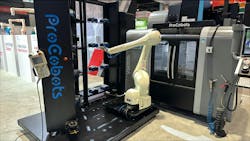Hurco and Kawasaki Robotics collaborate on CNC machine tending shelf system
Hurco’s customers said they would buy a new computer-numerical-control (CNC) machine if Hurco could get them an operator. Manpower wasn’t in the company’s repertoire, but Hurco knew automation and robotics could help alleviate labor-force issues facing machine shops.
Hurco unveiled its robotic machine-tending shelf system in collaboration with Kawasaki Robotics. Aimed at high-mix, low-volume manufacturers who don’t want to learn how to program a robot, the turnkey, no-code system will come out of the box designed and ready for the application.
Get your subscription to Control Design’s daily newsletter.
Hurco manufactures CNC machines for a wide range of customers. While it does serve some large customers, its primary market is job shops with significant part changeover, and small- to medium-sized enterprises. “Our focus has been in providing technology that's very simple to use and effective for programming and running the machine tools, and we've extended that to the machine-tending automation, as well,” says Paul Gray, executive vice president of engineering, R&D and product development at Hurco.
In 2023, Hurco began discussions with Kawasaki about a collaboration, keyed on each company’s strengths: CNC machines and industrial robots. Development time was about a year from initial discussions to design cycles, including controls development to integrate the Kawasaki controller with the Hurco Job Manager software, which it had originally developed for collaborative robots. “We made a nice, seamless system that is conversationally driven, like our CNC control, to be able to control the robotic cell with the CNC machine and orchestrate the machine tending,” Gray says.
Before this project, Hurco had acquired ProCobots, a collaborative robot system integrator, designed to accelerate Hurco’s foray into automated machine tending.
When Hurco first introduced automation to its CNC customers, the company learned quickly that CNC operators are more focused on the machine, how to program and run it and cut quality parts, as that is the manufacturer’s primary business objective. “They really didn't have the time and didn't have the desire to learn how to program a robot controller and do all that work themselves. They needed something that would basically be as plug-and-play as possible, low connected to their CNC machine so that they can make parts,” Gray says. “When we deliver the machine, it’s basically plug-and-play with the machine.” The whole system includes not just the CNC machine, robot, shelves and pallets, but also the Ethernet connection between the robot, the software and the electrical and pneumatic connections.
“It's been designed by our engineers who also design our machines, and also the software that drives all of this is designed, developed and executed by our software engineers, as well,” Gray says.
The Kawasaki system uses an industrial robot for a few reasons. “One is that we're using this with a pallet-based system, which could be vices or straight pallets, where we mount parts directly to a pallet, and we're using a cleat and single gripper system to pick up a pallet then load it into a receiver in the CNC machine,” Gray says. “We’re not gripping parts directly. We’re gripping something that’s holding the part to load into the machine, and then return it to the shelf when it’s completed.” While collaborative robots have significantly increased payload as of late, this system didn’t need a lot of repositioning or tweaking, as the pallets are picked and reloaded consistently in the same array. Depending on the pallet, they weigh around 10 lb. Given a higher payload with pallets and parts and the longer reach needed for CNC machine tending, the industrial robot was the right choice, Gray says. It also allows for the system to scale even larger.
Hurco’s software Job Manager communicates with Hurco’s WinMax CNC Controls using Ethernet TCP/IP, and Hurco used the same software with the Kawasaki control to integrate and communicate with the Kawasaki controller. “There are robot programs running on the Kawasaki, which handle a lot of the robotic motion, but the orchestration of the whole cell of the CNC machine tool and the robot is conducted and driven by the Hurco Job Manager,” Gray adds.
Set up is simple with Job Manager. Via a simple interface, operators select which pallets have which CNC programs and where they are located in the shelving system, and queue up the appropriate jobs and press start. “It basically makes it a simple, conversational way to tell the system what I am going to make and how much of it I am going to make and where it is in the shelving system, and they're not having to touch or deal with or program anything on the robot control or even the CNC machine, other than having the CNC program ready to cut the part,” Gray says.
The modular shelf system can be expanded to fit different size or quantity of parts or to handle higher payloads. The system on display at IMTS in September, which sold at the show, included a Kawasaki RS013N industrial robot, but the system will work with any of Kawasaki’s industrial robots.
One key feature of the RS013N industrial robot is the integrated valves in drum three and an integrated I/O cable that goes up through the arm, which makes cable routing around the tool much simpler. “It reduces the amount of cable that the robot has to navigate around while going in and out of the machine, making the cell more compact and easier to integrate,” says Gilles Renard, application engineering team leader at Kawasaki Robotics.
Kawasaki, Renard says, is also very proud of its open architecture on the controller side. “People can use the robot and program it normally, or they can create their own system that controls the robot from an outside source. And that's what allowed this interface to exist,” Renard says.
The system uses LiteVise grippers from 5th Axis. They have the same clamping force as standard vices, but, with an aluminum body, they are lighter for the robot to load. “It’s designed exactly for pallet loading. We can screw on the zero-point clamp system directly to the bottom devices and the cleats for the gripper to hold, including the gripper that is mounted at the end of the robot,” Gray says.
The CNC system on display at IMTS was Hurco’s VM15Di CNC machine. “It’s a very nice machine because it has an inline spindle, which gives you a really good surface finish and very good acceleration/deceleration times, so it’s ideal for continually loading parts in and out and running automation,” Gray says.
When customers told Hurco, they would buy a machine, if they could get an operator, Hurco now has an answer for the labor-force decline. Where one operator is typically working four machines, setting up jobs on one and running parts to others, a machine-tending system alleviates some of that load, so operators can focus on less tedious tasks.
About the Author
Anna Townshend
Managing Editor
Anna Townshend has been a writer and journalist for 20 years. Previously, she was the editor of Marina Dock Age and International Dredging Review, until she joined Endeavor Business Media in June 2020. She is the managing editor of Control Design and Plant Services.

Leaders relevant to this article:

